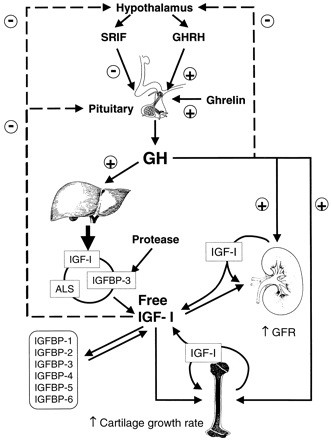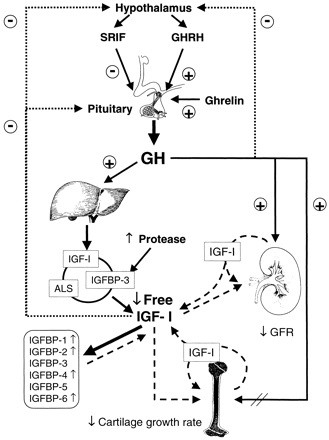Growth Hormone/IGF-I Axis
About Growth Hormone/IGF-I Axis
The growth hormone/IGF-I axis is an important endocrine system involved in the regulation of growth and developmental processes. It consists of growth hormone (GH), growth hormone-releasing hormone (GHRH), and growth inhibitor (Somatostatin), as well as its downstream insulin-like growth factor-I (IGF-I).
GH is a protein hormone secreted by the anterior pituitary gland and its release is regulated through interactions with GHRH and insulin-like growth factor release inhibiting hormone (GID).GH stimulates the synthesis and release of IGF-I in the liver and other tissues. IGF-I is a polypeptide hormone synthesized primarily in the liver and also secreted by other tissues. Its synthesis is regulated by GH but also by other factors (e.g., nutritional status and growth factors.). IGF-I binds to its receptor on the cell membrane and regulates cell proliferation, differentiation, and survival through downstream signaling pathways.
The GH/IGF-I axis plays an important role in growth processes such as embryonic development, pubertal growth in children, bone development, and muscle growth. In addition, the GH/IGF-I axis is also involved in physiological processes such as metabolic regulation, immune function, brain function, and cardiovascular health. Abnormalities in the function of the GH/IGF-I axis have been associated with a variety of diseases. For example, GH overproduction causes gigantism; GH deficiency leads to dwarfism; and IGF-I deficiency or resistance is associated with developmental delay, osteoporosis, and muscle wasting. In addition, dysregulation of the GH/IGF-I axis may be associated with the development of metabolic syndrome, tumor growth, and neurodegenerative diseases.
Exploration and understanding of the GH/IGF-I axis can help to gain insight into the pathogenesis of related diseases and may provide new ideas for developing therapeutic approaches for related diseases.
 Fig.1 The somatotropic axis. (Roelfsema V, et al., 2001)
Fig.1 The somatotropic axis. (Roelfsema V, et al., 2001)
The synthesis and release of growth hormone (GH) from the pituitary are controlled by the hypothalamic hormones GH-releasing hormone (GHRH) and somatostatin (SRIF), which in turn are regulated by feedback (dashed lines) from blood GH and insulin-like growth factor-I (IGF-I) concentrations. The recently discovered endogenous GH-releasing peptide, called ghrelin, also stimulates GH release. Circulating GH acts directly on many organs to stimulate IGF-I production, with IGF-I production in the liver providing the main source of blood IGF-I. Most of the IGF-I in the circulation is bound to IGF-binding protein-3 (IGFBP-3) in a ternary complex with acid-labile subunit (ALS); a smaller fraction is bound to the five other IGFBP. A small fraction of the total IGF-I in blood is in a bioactive-free fraction. In the kidney, IGF-I increases renal plasma flow and GFR, whereas on bone it acts on the epiphysial plate, which leads to longitudinal bone growth. As illustrated, GH also has direct effects on many organs, including kidney and cartilage, which can be independent of IGF-I action.
Mechanisms of Action or Signaling Pathways of the Growth Hormone/IGF-I Axis
The growth hormone/IGF-I axis acts through a series of cascading events. The pituitary gland releases GH in response to hypothalamic stimulation (Growth Hormone Releasing Hormone, GHRH), which then binds to receptors on target cells, initiating signaling pathways that lead to the production of IGF-I, which activate downstream signaling pathways to exert its biological effects by binding to its specific receptor. These pathways involve the activation of PI3K/Akt and MAPK/ERK cascades, which regulate cell growth, proliferation, and survival.
The growth hormone/IGF-I axis is primarily involved in the interaction between GH and IGF-I.
- In anterior pituitary cells, the action of growth hormone-releasing hormone (GHRH) increases growth hormone synthesis and release through a cAMP-dependent signaling pathway. In contrast, the growth hormone growth inhibitory hormone (GHIH) decreases growth hormone synthesis and release by inhibiting cAMP signaling.
- Growth hormone exerts its effects in target tissues by binding to the cell surface growth hormone receptor (GHR), a single transmembrane receptor. When growth hormone binds to the GHR, it triggers dimerization and self-activation of the receptor, and the activated GHR transmits the effects of growth hormone by activating multiple signaling pathways (e.g., JAK/STAT, MAPK).
- Growth hormone regulates cellular gene expression through activation of the JAK/STAT signaling pathway, which plays an important role in promoting cell proliferation, enhancing protein synthesis, and inhibiting apoptosis.
- Growth hormone also stimulates hepatic cells to synthesize and secrete insulin-like growth factor-I (IGF-I), a peptide hormone that transmits its biological effects by binding to the cell-surface IGF-I receptor, a receptor with tyrosine kinase activity, which is activated through downstream signaling pathways such as Ras/Raf/MEK/MAPK, PI3K/Akt, etc., which are involved in the regulation of cell proliferation, growth, and differentiation.
- IGF-I is not only secreted from the liver into the blood circulation but also produced and released in other tissues and cells. IGF-I is involved in cell growth and differentiation, as well as tissue and organ development and repair through its endocytosis and the endocytosis of growth hormone.
The Role of Growth Hormone/IGF-I Axis
The growth hormone/IGF-I axis plays a critical role in human health and development. Some of the key functions and roles of this axis include:
- Bone Growth and Development: GH and IGF-I play a key role in the growth and development of bone and cartilage. They stimulate cell division, differentiation, and matrix synthesis in skeletal tissues and help ensure that longitudinal bone growth occurs properly during childhood and adolescence.
- Metabolic Regulation: The Growth hormone/IGF-I axis influences a variety of metabolic processes. GH enhances lipolysis, promoting the breakdown of stored fat and increasing the availability of energy substrates. While IGF-I promotes protein synthesis and building metabolism, contributing to muscle growth and repair.
- Regulation of Organ Function: The growth hormone/IGF-I axis affects the function of several organs, including the liver, heart, and kidneys. GH and IGF-I support liver function by promoting the production of insulin-like growth factor-binding proteins (IGFBPs) and facilitating glucose metabolism. They also play a role in cardiovascular health by regulating heart function and vascular homeostasis.
- Immune System Modulation: GH and IGF-I have immunomodulatory effects and influence the function of immune cells. They regulate the production and activity of immune cells and influence the immune response and inflammatory reactions.
The growth hormone/IGF-I axis plays a key role in embryonic development, child growth, and adult metabolism. When GH or IGF-I production or function is compromised, it may lead to problems such as growth retardation, muscle wasting, decreased bone density, and metabolic disorders. Therefore, the study and understanding of this biochemical axis is of great importance in the field of medicine and health.
 Fig.2 Deranged somatotropic axis in chronic renal failure. The GH/IGF-I axis in chronic renal failure (CRF) is changed markedly compared with the normal axis.
Fig.2 Deranged somatotropic axis in chronic renal failure. The GH/IGF-I axis in chronic renal failure (CRF) is changed markedly compared with the normal axis.
(Roelfsema V, et al., 2001)
Available Resources for Growth Hormone/IGF-I Axis
Creative BioMart offers products and services related to the growth hormone/IGF-I axis, providing a valuable resource for researchers studying this complex regulatory system. Through their products, researchers can delve deeper into the mechanisms and functions of the growth hormone/IGF-I axis, advancing our understanding of its intricate role in human physiology and paving the way for potential therapeutic interventions.
The following growth hormone/IGF-I axis-related molecules/targets are displayed, click to view all products. Please feel free to contact us with any questions or requests.
References:
- Junnila R K, List E O, Berryman D E, et al. The GH/IGF-1 axis in aging and longevity[J]. Nature Reviews Endocrinology, 2013, 9(6): 366-376.
- Roelfsema V, Clark RG. The growth hormone and insulin-like growth factor axis: its manipulation for the benefit of growth disorders in renal failure. J Am Soc Nephrol. 2001;12(6):1297-1306. doi:10.1681/ASN.V1261297.
- Blum WF, Alherbish A, Alsagheir A, et al. The growth hormone-insulin-like growth factor-I axis in the diagnosis and treatment of growth disorders. Endocr Connect. 2018;7(6):R212-R222. doi:10.1530/EC-18-0099.


